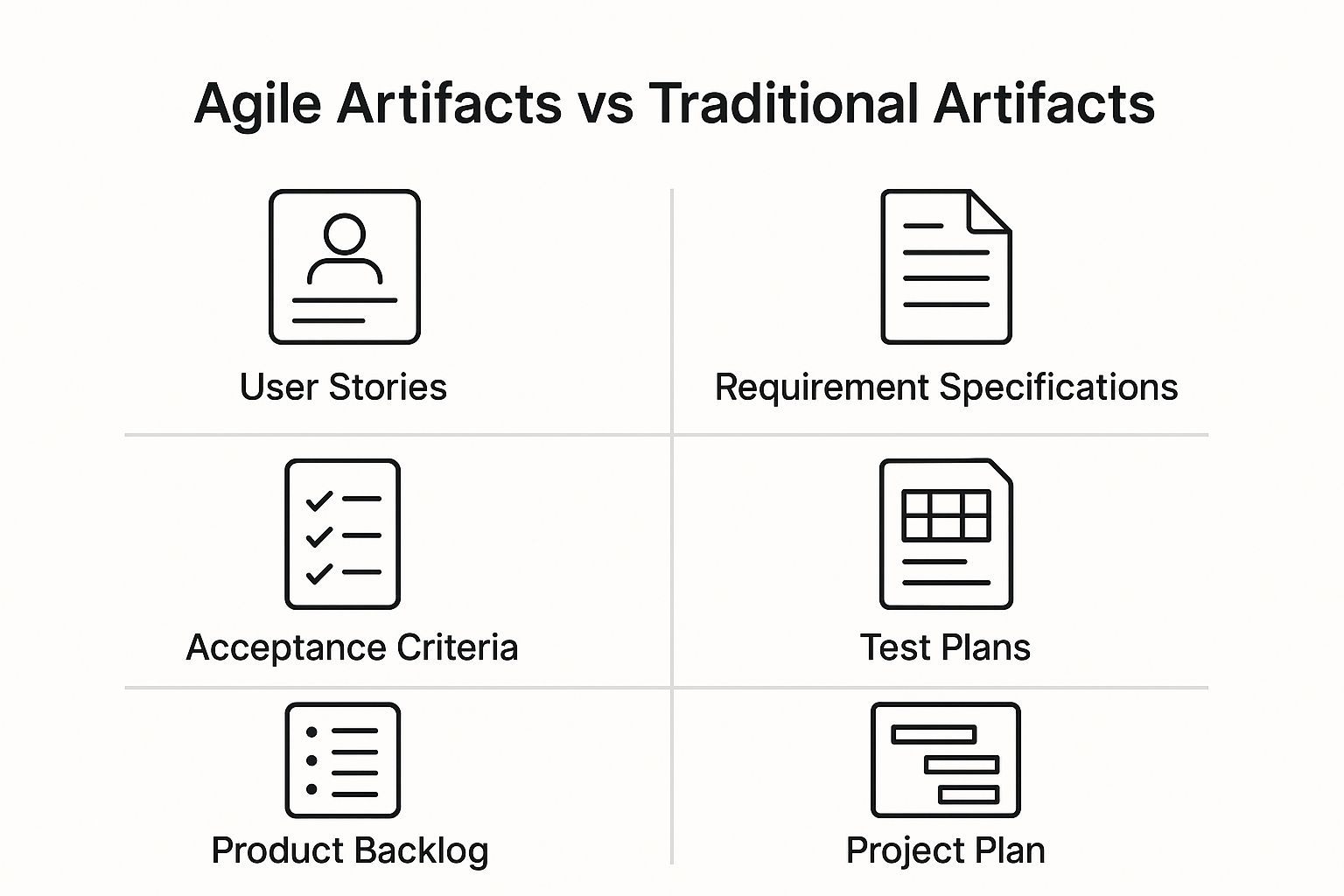Mastering Agile Requirements Documentation
Agile requirements documentation is all about being lean and responsive. Instead of creating massive, all-encompassing documents before a single line of code is written, it focuses on providing the right amount of information at the right time. Think of it less as a rigid instruction manual and more as a living, breathing guide that evolves with the project. It's built around collaborative tools like user stories and backlogs, ensuring the development team is always working on what truly matters to the user.
Moving Beyond Traditional Requirements

To really get why agile documentation is so effective, it helps to understand what came before it. For years, the software world ran on the Waterfall model. This was a strict, sequential process where you had to fully complete one phase before moving to the next. This approach required enormous, detailed requirements documents to be written and signed off at the very beginning of a project.
Think of it like building a skyscraper the old-fashioned way. The architects would draft a complete, unchangeable blueprint detailing every single wire, pipe, and window before anyone even broke ground. Once that blueprint was approved, it was set in stone. If a better building material came along or the client wanted to add a balcony mid-construction, making a change was a nightmare—if not outright impossible. That’s exactly how traditional documentation felt: static, exhaustive, and based on the fragile assumption that you could know everything on day one.
The Problem with Rigid Blueprints
This old-school method created a lot of headaches. Teams would spend months writing hundreds of pages of specifications, often based on guesswork that turned out to be wrong. By the time the product was finally delivered, sometimes years later, the market had changed, and the features that were so meticulously documented were no longer what people wanted.
The core issue with traditional documentation is its resistance to change. It treats product development as a predictable, linear process, which rarely reflects the reality of building innovative software.
This rigidity consistently led to some major problems:
- Wasted Effort: A staggering amount of time was spent documenting features that were later scrapped or completely overhauled.
- Slow Time-to-Market: The huge upfront documentation phase meant that actual development didn't start for months, pushing back launch dates.
- Misaligned Outcomes: Since real customer feedback didn't come until the very end, the final product often failed to meet user expectations.
- Lack of Collaboration: Documentation was typically created in a vacuum by business analysts and then "thrown over the wall" to developers, causing endless confusion and misinterpretation.
The Shift to a Dynamic GPS
Agile requirements documentation was born out of these frustrations. It's a complete shift in thinking. Instead of a static blueprint, imagine using a modern GPS for a road trip. A GPS doesn't spit out every single turn for a 3,000-mile journey at the start. It gives you the next few critical directions while constantly recalculating based on real-time traffic, roadblocks, and where you are right now.
That’s agile documentation in a nutshell. It’s created in small, collaborative bursts, giving the team just enough detail to build the next valuable piece of the product. It doesn't just tolerate change; it expects it.
This mindset is all about responding to new information instead of blindly following a plan. To dig deeper into how these two worlds differ, it's worth exploring a detailed comparison of project management with Waterfall vs. Agile. The goal is to make sure that what you're building is always aligned with what the business and its users need today, not what they thought they needed a year ago.
Understanding Core Agile Documentation Principles
Let's get one thing straight: Agile documentation isn't about no documentation. It's about no waste. It’s a complete mindset shift, moving away from documentation as a static, contractual handcuff to seeing it as a dynamic tool that actually helps the team build better software, faster.
The whole point is to ditch the exhaustive, upfront rulebooks and instead create just enough information, at just the right time, to get the job done. Anything that doesn't directly help build a great product is considered waste.
The Principle of Just-in-Time Detailing
Think of a Michelin-star chef crafting a multi-course dinner. The old-school, waterfall approach would be to cook every single dish to completion before the first guest even walks in. It’s a recipe for disaster. Appetizers get cold, sauces break, and the timing is all wrong.
An agile chef, on the other hand, works just-in-time. They prep ingredients, but they only fire up the pan for the first course right before it’s served. Then they move on to the next. Everything is fresh, perfectly timed, and delicious.
Agile requirements follow the exact same logic. Instead of mapping out every feature for the next 12 months in painstaking detail, teams focus only on what's coming up in the next sprint or two. This keeps the details relevant and ensures they’re based on the latest feedback and understanding—not on assumptions made months ago.
Documentation as a Living Artifact
Traditional project documents are often treated like ancient relics. They’re written, signed off on, and then archived in a digital tomb, never to be seen again. Within weeks, they’re hopelessly out of date as the project inevitably changes.
In stark contrast, agile documentation is a living artifact. It’s expected to evolve right alongside the product.
In an agile world, documentation isn't a phase you power through and check off a list. It's a continuous, breathing activity. The most valuable documents are the ones that are easy to update and always reflect the current state of the project, acting as a single source of truth for the entire team.
This is why agile teams gravitate toward collaborative tools like Confluence or Jira. These platforms make it easy to update requirements in real-time as new insights pop up from sprint reviews, customer calls, or hallway conversations. The document is never truly "done" until the product is.
Prioritizing Conversations Over Contracts
This might be the most powerful principle of all. Agile teams value a quick, direct conversation far more than a long, formal document. A five-minute chat between a developer and a product owner can solve a problem that a 20-page spec sheet would only complicate.
Of course, this doesn't mean conversations replace documentation. It means the documentation's job is to capture the results of those conversations. A critical part of this is writing clear user stories and rock-solid acceptance criteria so everyone agrees on what "done" actually means. Nailing this down is essential for avoiding confusion. For anyone wanting to dig deeper, there's a complete guide on acceptance criteria for user stories that really breaks it down with great examples.
This principle comes to life in daily team activities:
- Daily Stand-ups: Fast-paced check-ins to sync up on progress and roadblocks.
- Backlog Refinement: Ongoing meetings to discuss, estimate, and clarify upcoming work.
- Sprint Planning: The whole team gets together to decide what they can realistically deliver in the next sprint.
By leaning into these ideas, agile teams create documentation that serves a real purpose. It provides clarity and guides development, all without getting bogged down in the bureaucratic sludge of old-school methods.
Your Toolkit for Agile Requirements
Moving from theory to practice means you need the right tools. When we talk about agile requirements, we’re not talking about a single, massive document. Instead, think of it as a specialized workshop where each tool helps you shape a raw idea into a polished, functional piece of software.
Let's open up the toolbox and take a look at the essentials.
H3 User Stories: The Voice of the Customer
At the very heart of agile requirements is the User Story. It’s a simple, concise description of a feature, always told from the perspective of the person who actually wants it—usually a user or customer.
The most common format you'll see is: "As a [type of user], I want [some goal] so that [some reason]."
This structure looks simple, but it’s incredibly powerful. It forces the entire team to constantly think about the who, what, and why behind every single feature. This focus prevents you from building things that sound cool but don't actually deliver any real value. A good user story isn't a detailed contract; it's a promise to have a conversation later.
To keep user stories effective and ready for development, many experienced teams rely on the INVEST criteria:
- Independent: Can this story be developed on its own?
- Negotiable: Is there room for discussion and collaboration on the details?
- Valuable: Does it deliver clear value to the user or the business?
- Estimable: Can the team give a rough estimate of the effort involved?
- Small: Is it small enough to be completed within a single sprint?
- Testable: Do we know how to verify that the story is truly "done"?
H3 Acceptance Criteria: Defining “Done”
If a user story explains the "why," then Acceptance Criteria define the "what." These are the specific, testable conditions a feature must meet before it can be considered complete and working as intended. Think of them as the final checklist you run through to confidently say, "Yep, this is done."
Clear acceptance criteria are your best defense against ambiguity. They prevent those frustrating "that's not what I meant" conversations at the end of a sprint. Many teams use the Gherkin syntax (Given/When/Then) because it’s so clear and easy to understand.
For a password reset story, it might look like this:
Given I am on the login page and have forgotten my password,
When I click the "Forgot Password" link and enter my registered email,
Then I should receive an email with a secure link to reset my password.
H3 The Product Backlog: The Living Roadmap
The Product Backlog is the single source of truth for all the work your team needs to tackle. It's an ordered list of everything that might be needed for the product—user stories, new features, bug fixes, you name it. The Product Owner is responsible for keeping this list prioritized and in good shape.
This is worlds away from a traditional, fixed project plan. The backlog is a living, breathing artifact. Items at the top are detailed and ready for the next sprint, while things further down are less defined. This gives the team the flexibility to adapt to new information and shifting priorities without derailing the whole project.
This dynamic approach is now mainstream. According to the 17th Annual State of Agile Report, frameworks built on backlogs are dominant, with Scrum used by 87% of Agile teams and Kanban by 56%. This data confirms a massive shift away from static plans toward documentation that evolves just-in-time. You can discover more agile methodology insights and see how teams are putting these ideas into practice.
H3 Story Maps: Visualizing the User Journey
Sometimes, a flat list just doesn't cut it. A Story Map gives you the powerful visual context a simple backlog can't. It organizes user stories along two dimensions: the horizontal axis shows the user's journey through the product from start to finish (the "narrative flow"), while the vertical axis shows the priority of features within each step.
This layout helps everyone see the big picture. It makes it easy to spot gaps in the user experience and make smarter decisions about which features to build first to deliver the most value, as quickly as possible. It's a fantastic tool for release planning.
H3 Wireframes and Prototypes: Making Ideas Tangible
Let's be honest: words can only take you so far. Wireframes and Prototypes are simple visual guides that bring ideas to life by showing how a feature will look and function.
A wireframe is a low-fidelity, black-and-white sketch that focuses purely on structure and layout. A prototype, on the other hand, is a more interactive, high-fidelity model that actually simulates the user experience.
These visual aids are invaluable for getting early feedback. A stakeholder can glance at a wireframe and instantly spot an issue that would have been buried in pages of text, saving you countless hours of rework down the line.
The table below contrasts these agile tools with their more traditional counterparts, highlighting the fundamental shift in thinking.
Comparison of Traditional vs Agile Documentation Artifacts
This table contrasts key Agile documentation artifacts with their traditional waterfall equivalents to highlight fundamental differences in purpose, detail, and creation timing.
| Aspect | Traditional Waterfall Artifact | Agile Artifact |
|---|---|---|
| Purpose | A formal, binding contract for what will be built. | A placeholder for a conversation; a shared understanding. |
| Timing | Created exhaustively upfront, before development begins. | Created "just-in-time" throughout the project lifecycle. |
| Detail Level | Highly detailed and comprehensive to cover all possibilities. | Lightweight and high-level, with details added collaboratively. |
| Key Document | Business Requirements Document (BRD), Software Requirement Specification (SRS) | Product Backlog, User Stories |
| Visual Aid | Detailed UI mockups, often created by a separate team. | Low-fidelity wireframes and interactive prototypes, created collaboratively. |
| Change | Changes are difficult and require a formal change request process. | Changes are expected and welcomed to adapt to new learning. |
This comparison makes it clear how the agile approach moves away from exhaustive, static documents toward dynamic, collaborative tools focused on iterative value.

As the infographic shows, the entire philosophy is different. It’s less about creating a perfect plan from the start and more about building a framework for continuous learning and adaptation.
Making Agile Documentation Work: Best Practices from the Trenches

Having the right agile tools is one thing, but knowing how to use them is what really separates successful teams from the ones who just spin their wheels. If you simply adopt user stories and backlogs without shifting your mindset, you're just creating a different kind of chaos.
The teams that really nail this follow a few core practices. These habits transform documentation from a tedious chore into a powerful tool that helps everyone build better products. It’s not about just writing things down; it’s about creating a shared understanding that smooths out the entire development process.
Set Up Clear Guardrails for Your Workflow
The fastest way to kill momentum is with ambiguity. That's where two critical concepts come into play: the Definition of Ready (DoR) and the Definition of Done (DoD). Think of them as the quality gates for your entire workflow.
The Definition of Ready is your team's checklist for a user story before it can even be considered for a sprint. This simple agreement stops developers from getting stuck with half-baked ideas.
A story might be considered "Ready" only if it has:
- A clear statement of value for the user.
- Specific, testable acceptance criteria.
- All dependencies identified and sorted out.
- A rough estimate from the team.
On the other end of the process, the Definition of Done is the universal standard a story must meet to be considered complete. This is what ends the dreaded "well, it works on my machine" debate for good.
Your DoD is a non-negotiable team agreement. It removes any guesswork about what "done" truly means, ensuring every feature is actually ready to go.
This is a living document, but it typically includes things like "code has been peer-reviewed," "all automated tests are passing," and "relevant documentation is updated."
Make Deep Collaboration Your Default Mode
In agile, documentation is a team sport—it lives and breathes through constant communication. When people work in silos, the whole system breaks down. Product owners, developers, and QA specialists have to be in a continuous conversation to shape and refine requirements.
This means swapping out long, confusing email threads for quick, focused chats. A daily stand-up, a huddle around a whiteboard, or a 5-minute video call can solve in moments what might take hours to untangle through text. You have to build this collaborative spirit on purpose.
Backlog refinement sessions are where this really happens. These aren't just meetings for the product owner to dictate terms. They are hands-on working sessions where the whole team pulls stories apart, asks tough questions, and gets on the same page. This builds collective ownership, ensuring everyone understands the why behind the work, not just the what. This is a lot like creating standard operating procedures (SOPs) for a business, where the goal is to create absolute clarity. In fact, you can learn how to create SOPs and see just how powerful structured, shared documentation can be.
Treat Your Documentation Like a Living System
Static documents are the kryptonite of agile. The second you export your backlog to a PDF or spreadsheet, it’s already obsolete. The best teams treat their documentation as a living, breathing part of the project.
This is why tools like Jira and Confluence are so dominant. They create a single source of truth that everyone can see and update in real time. User stories are linked directly to code commits, test plans, and design mockups, creating a clear, traceable line from the initial idea all the way to the finished feature.
With this approach, your documentation is never just a historical artifact. It’s an active, useful guide that accurately reflects the project's current state. When a requirement changes, it gets updated in one central place, and the whole team is instantly aligned. That’s how you keep your agile documentation lean, valuable, and trustworthy.
Scaling Documentation for Large Agile Projects
https://www.youtube.com/embed/z8LOadgOV98
When a single agile team is building a product, keeping documentation light and focused is pretty simple. But what happens when you have ten, twenty, or even fifty teams all working on the same massive project? This is where agile requirements documentation truly gets put to the test.
All of a sudden, you’re juggling complex dependencies, trying to keep everyone aligned, and fighting the risk of creating a bureaucratic nightmare that stifles the very agility you’re aiming for. Scaling documentation isn't just about writing more stuff. It's about building a smart communication system that connects teams without getting in their way. This is where scaled agile frameworks like SAFe (Scaled Agile Framework) or LeSS (Large-Scale Scrum) often come into play.
Maintaining Alignment with High-Level Goals
In a big company, individual teams are busy cranking out User Stories. The trick is making sure all those small stories roll up to achieve larger, strategic goals. In frameworks like SAFe, these are often called Epics or Features. The real challenge is making sure every single team understands how their small piece of the puzzle fits into the big picture.
Your documentation needs to create a clear, traceable line from the highest-level business objective all the way down to the tiniest task. Think of this hierarchy as a map that keeps everyone rowing in the same direction.
- Epics: These are the big-ticket items—major business initiatives that might take several months to complete (e.g., "Launch International Payment Processing").
- Features: Epics are then carved up into Features, which are specific chunks of value for the customer (e.g., "Enable Credit Card Payments in the EU").
- User Stories: Finally, teams break those Features down into small, manageable User Stories they can knock out in a single sprint (e.g., "As a German customer, I want to pay with a Visa card…").
A well-structured documentation hierarchy ensures that no team is working in a silo. It provides the "why" behind every task, connecting daily work directly to strategic business value.
This layered approach gives everyone just the right amount of information. Executives can track the progress of major Epics, while development teams have the concrete details they need to build their stories. When you're dealing with this level of complexity, Mastering Enterprise Content Management Solutions becomes critical for keeping all this documentation organized and accessible.
Managing Cross-Team Dependencies
Dependencies are just a fact of life when multiple teams are working on interconnected systems. Team A can't finish their part until Team B delivers that crucial API. If you don't have a system to track this, your project can easily grind to a halt.
This is where scaled agile frameworks introduce specific events and artifacts to make these connections visible. For example, Program Increment (PI) Planning, a cornerstone event in SAFe, brings all the teams together to map out their work for the next 8-12 weeks. They identify who depends on whom and create a program board—a giant visual map showing how features and dependencies link up across all teams and sprints.
This proactive documentation is a world away from old-school methods. The data shows it works, especially in large organizations. For instance, Deloitte reported that by 2017, a staggering 80% of U.S. federal IT projects were using Agile methods. That’s a huge leap from just 10% in 2011, a shift driven by the need to avoid the risks and delays caused by rigid, outdated requirement documents. You can dive deeper into this industry-wide transition and read the full research on agile adoption statistics.
How Agile Documentation Fuels Business Success

It’s easy to think of agile documentation as just another project management task, but that's selling it short. When done right—lean, collaborative, and laser-focused on value—it becomes a powerful engine for real business results. It’s the connective tissue that keeps your development sprints locked in on strategic goals, making sure every ounce of effort delivers something meaningful to the customer.
Think of it as a direct line to a faster time-to-market. Instead of getting paralyzed by massive upfront planning, your team can start building and shipping valuable features almost immediately. That kind of speed gives your business the agility to pounce on market changes, outmaneuver competitors, and start bringing in revenue sooner.
Driving Quality and Making Customers Happier
A major win here is a dramatic improvement in product quality. Since agile documentation is built around constant feedback loops and crystal-clear acceptance criteria, teams spot and fix misunderstandings early and often. This cycle of continuous refinement slashes bugs and avoids expensive rework, resulting in a rock-solid product that people genuinely enjoy using.
By focusing on conversations and shared understanding, agile documentation ensures that the team is always building the right thing. This alignment is the secret to creating products that don't just work, but also solve real customer problems and earn their loyalty.
This customer-first mindset delivers some serious returns. Companies that build a strong Agile culture have seen their commercial performance jump by an incredible 237%. It all comes down to prioritizing quick delivery and responding to customer needs—which happens to be the top goal for 83% of companies undergoing a transformation. You can dig into even more agile project management statistics to see the full picture.
Building a Lasting Competitive Edge
Ultimately, agile requirements documentation helps create a more responsive and resilient organization. It nurtures a culture where everyone, from developers to marketers, is invested in the final outcome. This kind of deep teamwork is crucial, and truly understanding what cross-functional collaboration is can take your efficiency to the next level.
By embracing change and staying fixated on delivering value, businesses can consistently stay ahead of the curve. This makes agile documentation much more than just a process—it’s a cornerstone of modern success.
Answering Common Questions About Agile Documentation
When teams first dip their toes into agile, a lot of questions pop up, especially around documentation. It's a big shift from the old way of doing things. Let's clear up some of the most common points of confusion.
"Isn't Agile Just an Excuse for No Documentation?"
This is the big one, the myth I hear all the time. The truth is, agile isn't anti-documentation; it's anti-waste.
The Agile Manifesto prioritizes "working software over comprehensive documentation," which is a crucial distinction. It doesn't say "no documentation." It means we create just enough documentation, at precisely the right time, to help the team build an amazing product.
Instead of spending months on a massive, static requirements document that's obsolete the day it's printed, agile teams create living, breathing artifacts. Think user stories and a dynamic product backlog. This way, the information is always current, always relevant, and directly tied to the work at hand.
"How Do You Ensure Quality Without a Detailed Spec?"
In a traditional setup, quality is often policed by a single, exhaustive document. In agile, quality is everyone's job, baked right into the process from day one. It's a shared understanding built on a few core practices.
- Acceptance Criteria: Every user story comes with a clear, testable set of conditions. This kills ambiguity and gives everyone a shared definition of what "done" actually means for that specific piece of work.
- Definition of Done (DoD): This is the team's pact. It's a simple checklist of everything that must happen before any work can be considered truly finished and ready to ship.
- Continuous Feedback: With regular sprint reviews and retrospectives, stakeholders are constantly seeing the product evolve. This creates a tight feedback loop, allowing the team to adjust course and refine its process on the fly.
The quality of agile documentation isn't measured by its page count. It comes from its clarity, its timeliness, and the collaboration that creates it. The goal is a shared understanding, not a long, prescriptive document that nobody reads.
"Can Agile Documentation Really Work in Regulated Industries?"
Yes, it absolutely can. Industries like finance, healthcare, or aerospace have strict traceability and compliance rules, but that doesn't rule out agile. You just have to be smart about it.
The trick is to weave compliance directly into your agile workflow. This could mean linking user stories back to specific regulatory requirements or using specialized tools to automatically generate an audit trail.
This hybrid approach gives you the best of both worlds: you get the flexibility and speed of agile while still producing the rock-solid documentation you need to prove compliance. It’s about adapting the process, not abandoning the rules.
Ready to stop wasting time on manual processes and start building scalable systems? MakeAutomation specializes in creating AI and automation frameworks that help B2B and SaaS companies accelerate growth and boost ROI. Learn how we can optimize your operations today!






